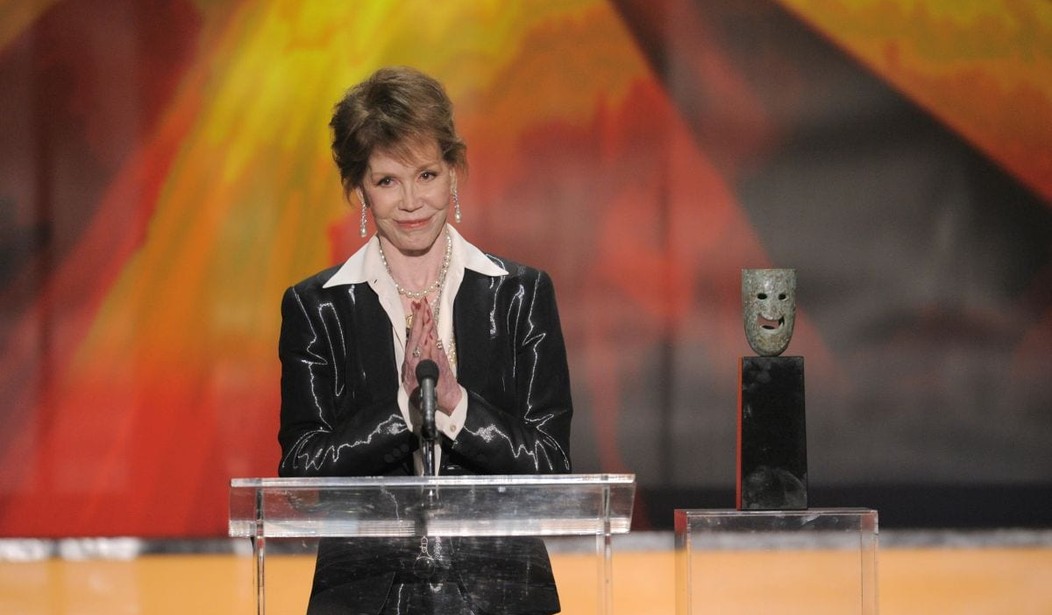Mary Tyler Moore, who played two of the most iconic female TV characters of all time, died of complications from pneumonia today. She was 80 years old.
An enormously talented actress and dancer, Moore parlayed those gifts into a career on stage, screen, and TV that spanned 50 years. She put an indelible imprint on the TV sitcom by revolutionizing the way that women were portrayed on the small screen. And she revolutionized the sitcom itself by ditching the tired, formulaic plots and characters for characters with depth who found themselves in real-life situations dealing with real-life problems.
The Mary Tyler Moore Show only ran from 1971 to 1977. But it burst on to the cultural consciousness at a time when record numbers of women were graduating from college and entering the work force. Moore’s character, Mary Richards, spoke to the problems, the dreams, the yearnings, and the pathos of these women in a way that no other female character has done.
Moore’s turn as Laura Petrie on the The Dick Van Dyke Show may not have been revolutionary, but it gave Moore a chance to show off her enormous comedic talents and acting chops. The show ran for only five years and was pulled by producer Carl Reiner while still ranked in Nielsen’s top 20 so that the principles could pursue other projects in film and on stage.
The New York Times on the impact of Mary Richards on the culture:
At least a decade before the twin figures of the harried working woman and the neurotic, unwed 30-something became media preoccupations, Ms. Moore’s portrayal — for which she won four of her seven Emmy Awards — expressed both the exuberance and the melancholy of the single career woman who could plot her own course without reference to cultural archetypes.
The show, and her portrayal of Mary as a sisterly presence in the office, as well as a source of ingenuity and humor, was a balm to widespread anxieties about women in the work force.
It modeled a productive style of coed collegiality, with Ms. Moore teasing out the various ironies known to any smart woman trying to keep from cracking up in a world of scowling male bosses and preening male soloists.
“Mary Tyler Moore became a feminist icon as Mary Richards,” said Jennifer Keishin Armstrong, the author of “Mary and Lou and Rhoda and Ted: And All the Brilliant Minds Who Made The Mary Tyler Moore Show a Classic.”
“She only wanted to play a great character, and she did so. That character also happened to be single, female, over 30, professional, independent, and not particularly obsessed with getting married. Mary had America facing such issues as equal pay, birth control, and sexual independence way back in the ’70s.”
The influence of Ms. Moore’s Mary Richards can be seen in the performances of almost all the great female sitcom stars who followed her, from Jennifer Aniston to Debra Messing to Tina Fey, who has said that she developed her acclaimed sitcom “30 Rock” and her character, the harried television writer Liz Lemon, by watching episodes of “The Mary Tyler Moore Show.” Many nonactresses also said that Ms. Moore — by playing a working single woman with such compassion and brio — inspired their performances in real life.
The show would not have been the cultural touchstone it became without a fabulous supporting cast of characters surrounding Moore.
In the show, Mary Richards was an associate news producer at WJM, a local television station in Minneapolis. Ed Asner played her boss, Lou Grant, who was gruff, though essentially tenderhearted; Gavin McLeod was Murray Slaughter, a news writer with a boring life; Ted Knight was the vain, dimwit anchorman, Ted Baxter.
The female characters, as finely drawn as the men, were Rhoda Morgenstern (Valerie Harper), Mary’s neighbor, also single; Phyllis Lindstrom (Cloris Leachman), Mary’s manipulative landlady; Georgette Franklin (Georgia Engel), Ted’s baby-voiced girlfriend (and later his wife); and Sue Ann Nivens (Betty White), the husband-stealing hostess of “The Happy Homemaker.”
That Rhoda was Jewish — as was Lou, the show sometimes implied — was unusual for network television at the time. Similarly novel were hints that Mary was sexually active.
The characters all revolved around Mary, whose naïveté and enthusiasm supplied a generous assist for the others’ eccentricities.
And what kept people coming back every week was the strong sense of family that infused each and every episode. Despite all their flaws, the characters genuinely cared about one another. Even the vainglorious Ted Knight occasionally stopped thinking about himself long enough to show concern and support for Mary or the other characters.
Ironically, the format of the show with its ensemble cast and edgy comedic scripts was endlessly copied in both the sitcom and TV drama genres. In the end, the show not only broke the mold, but created one as well.
The Mary Tyler Moore Show seems hopelessly dated now. But it’s still worth watching if only to see the comedic genius of Moore on display. A talent like hers comes along once in a lifetime and we were blessed to have been entertained and enlightened by her.









Join the conversation as a VIP Member